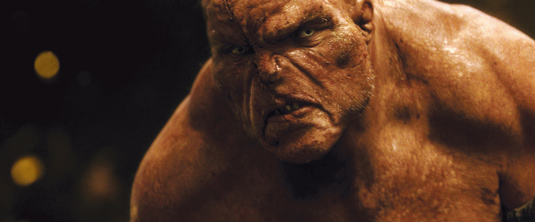The secrets of a samurai movie's muscular monster
VFX supervisor Nicolas Aithadi explains how hundreds of muscle sims were created for the CG demon in samurai epic 47 Ronin.

Amidst the epic sweeps across grand fantasy landscapes, Moving Picture Company's cherished achievement in samurai epic 47 Ronin was the twitching muscle animation of its Oni, a demonic character of gigantic proportions.
The initial concept had been modelled but the MPC team felt the Oni needed a new direction. According to MPC's VFX supervisor Nicolas Aithadi: "The Oni was supposed to be an enslaved creature who was forced to fight, so we designed a character who was powerful and could cause damage, but at the same time look like he had been abused for years, so people felt bad about killing him."
The challenge was to create an interesting animated character that viewers could believe in, and that meant a character who's carrying a bit of weight. "He's strong, but he's not going to the gym," explains Aithadi. "This was more interesting in terms of body motion.
Mighty muscles
"We found a muscular character wasn't very interesting, but we decided a bit of fat, with hanging skin, would be more sexy - in a graphical sense." The animators wanted to make the skin and muscle movement as accurate as possible, this meant adapting existing tools MPC use, and creating new workflows to ensure the muscle had weight when it moved and that the pectorals were affected by gravity.
"We had to write a muscle system in the rig, which enabled several muscles to be modelled as a simple shape; added to the rig and animated dynamically - these reacted to the motion of the actor," explains Aithadi, explaining: "The muscle could be deformed too, when his thigh moves up it would automatically move his belly up or to the right - it created some very interesting movement."

As the demon took shape, Aithadi's team wanted to recreate the effects of moving tendons across the muscle to create a more believable animation. “We looked at body builders and realised there’s more muscle twitching," says Aithadi. "To all that, we added extra details by modelling blend shapes to the animation - we ended up with hundreds of extra little models fired by the rig."
After hiring a model to act out the role, the team would add more detail on top of the animation as they spotted quirks in the performer’s muscles. The end result was a “combination of automatic simulation in the rig and hands-on modelling, stop-motion style, to get as much detail as we possibly could,” says Aithadi.
Daily design news, reviews, how-tos and more, as picked by the editors.
This article originally appeared in 3D World issue 180.

The Creative Bloq team is made up of a group of art and design enthusiasts, and has changed and evolved since Creative Bloq began back in 2012. The current website team consists of eight full-time members of staff: Editor Georgia Coggan, Deputy Editor Rosie Hilder, Ecommerce Editor Beren Neale, Senior News Editor Daniel Piper, Editor, Digital Art and 3D Ian Dean, Tech Reviews Editor Erlingur Einarsson, Ecommerce Writer Beth Nicholls and Staff Writer Natalie Fear, as well as a roster of freelancers from around the world. The ImagineFX magazine team also pitch in, ensuring that content from leading digital art publication ImagineFX is represented on Creative Bloq.
